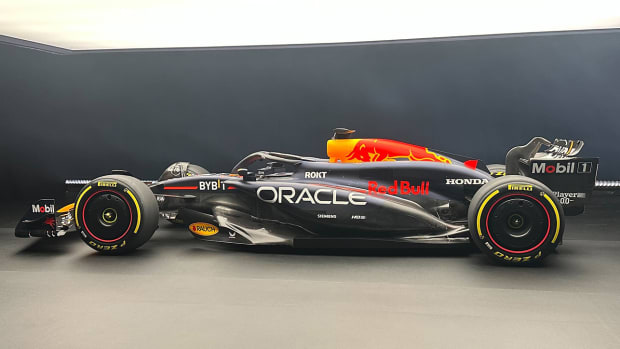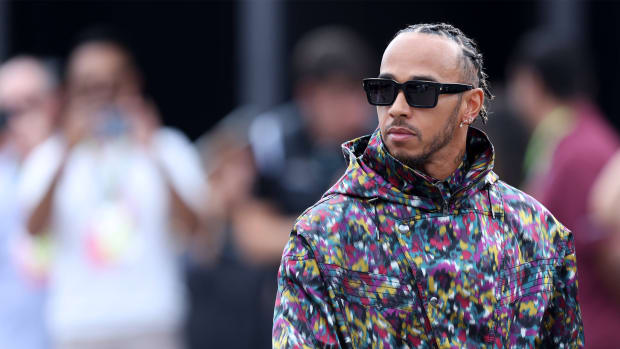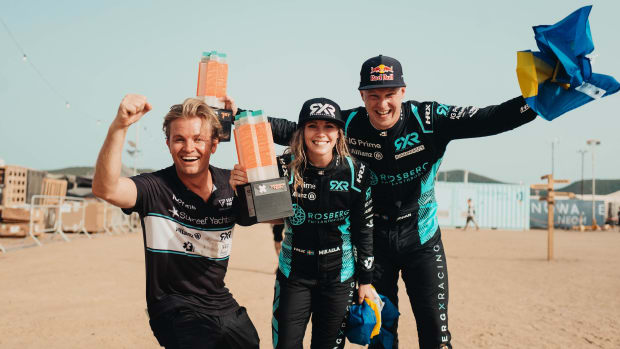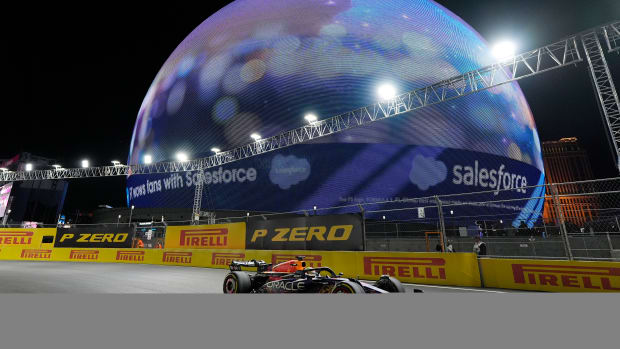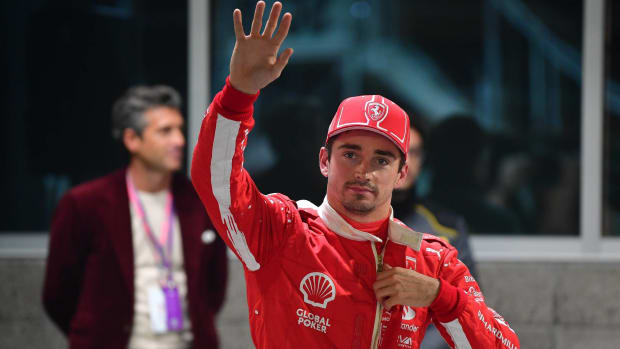Five Things to Watch at the 2023 Las Vegas Grand Prix
The Las Vegas Grand Prix is finally here. One of the most anticipated—and expensive—events to ever grace the Formula One calendar happens Saturday night, and there’s a lot to talk about. From racing on a new circuit layout to cold temperatures causing chaos, here are the biggest story lines as F1 takes to the sporting and entertainment capital of the world.

A shakeup from usual race starts, qualifying begins at midnight local time Saturday, with the race getting underway at 10 p.m. later that evening.
Gary A. Vasquez/USA TODAY Sports
F1 is heading into the unknown with a new track
The idea of an F1 race in Las Vegas isn’t new. In fact, the championship has raced there before in 1981 and ’82, but in a totally different location. The Caesars Palace Grand Prix took place in the parking lot of the famous hotel and was known for being one of the worst circuits ever. The uninspiring layout was also brutal on the necks of the drivers, and several suffered heat exhaustion after completing the race.
More than 40 years later, however, the pinnacle of motor sport is back in Sin City. The track is completely different from its predecessor, and it looks to be fast. Real fast. The Mercedes team said initial simulations show that just over 78% of the total lap distance will be taken at full throttle, and drivers should rack up top speeds making it the second-fastest track on the calendar, with only the Monza circuit, also known as the Temple of Speed, being faster. Racing down the iconic Las Vegas Strip and around attractions like the newly opened Sphere, the circuit reaches 6.201 kilometers and is made up of 17 corners.
Drivers had a chance to get to familiar with this street track on their team’s high-tech simulators during the week, although some have had an early preview from a less traditional source. Lots of the grid confessed to trying their luck on the F1 23 video game, with three-time world champion Max Verstappen admitting that he’d “hit more walls than I was going straight” during his last experience on the game. Everyone racing is supposed to get three hour-long practice sessions to get accustomed to the track before jumping into qualifying and then the race itself, but Thursday’s sessions were cut short after just 10 minutes due to a loose manhole cover.
The Las Vegas GP will be full of firsts
Another unique quirk of this weekend’s Las Vegas extravaganza is the schedule. To keep international audiences happy, especially those in Europe, the timings of sessions are very out of the ordinary.
Qualifying starts at midnight local time Saturday, with the race getting underway at 10 p.m. later that evening. As well as being the first time since the 1985 South African Grand Prix that an F1 race is happening on a Saturday, it will also be the latest start time in the championship’s 73-year history. Floodlights will surround the track, ensuring that visibility is as clear as if they were racing in daylight.
Plenty of drivers made their way to the U.S. early to adjust to the time zone, with the likes of Ferrari’s Charles Leclerc and Alpine’s Esteban Ocon spotted at a Los Angeles Lakers game Sunday evening.
Cold temperatures could cause chaos
F1 is no stranger to racing in deserts, especially at night. Just a glance at the 2023 calendar shows you Bahrain, Qatar and Abu Dhabi as examples. However, this Las Vegas race in mid-November might throw up a new challenge: single-digit Celsius temperatures. Things can get pretty chilly, and with such late sessions it could very well impact the cars and tires.
The lowest recorded temperature seen during a race was back in 1978 at the Canadian Grand Prix, where it reached only 5ºC (41ºF), with the average for Vegas at this time of year being 8ºC (46ºF). Although fans in the grandstands might be able to throw on another layer of clothing to combat the chill, the drivers aren’t so lucky.
One of the biggest question marks about this weekend has landed on Pirelli, F1’s sole tire supplier. The company already faced some challenges earlier this year, like when it had to limit tires to 18 laps per driver in Qatar after safety concerns arose. But, Las Vegas might be one of its toughest tasks yet as low track temperatures mean tires struggling to get heat on them.
But why is this important? Well, F1 tires are designed to work best during high temperatures. That’s why teams wrap up their next set of tires in heated blankets to make sure they’re as hot as possible by the time they take to the track. Cold temps will mean less grip, and could result in cars slipping and sliding all over the place. Mix that with the newly laid track surface, and we could be in for some complications. The lack of high-speed corners is also not in F1’s favor, with tire temperatures expected to plummet in the three long straights that make up the second-longest circuit of the year.
The Las Vegas circuit is also a street track, which means a barrier or wall is never too far, and, if drivers are struggling for grip on this foreign layout, we could see some expensive mistakes.
Sin City has undergone a big makeover
This magical city in the Nevada desert might be used to hosting the world’s biggest sporting, music and entertainment events, but none have had an impact quite like this weekend's Grand Prix. F1 has quite literally had to make Las Vegas change parts of its DNA to host the championship, from closing down roads to building grandstands on the fountain at the Bellagio.
Overlooking 20% of the circuit, The Venetian hotel is working in partnership with the Alpine F1 team for its off-track festivities. Alpine has been one of the most talked about teams of the year, especially with its string of famous investors this season that include Ryan Reynolds, Patrick Mahomes, Travis Kelce and Rory McIlroy, to name a few. The investor group, which is made up of three companies, acquired a 24% stake in the team during the summer as part of their €200m (around $217m) fund.
The Sphere at The Venetian has also taken a temporary pause from hosting U2, as the new high-tech venue is now in the hands of F1. Although they’ve kept tight-lipped about how they will utilize the state-of-the-art facility made up of an incredible LED screen to display video both inside and outside, fans are intrigued to see what they come up with.
With Las Vegas under a 10-year contract, and F1 having the rights to shut down the entire strip when the motor sport circus comes to town until 2032, F1 and Las Vegas’s partnership doesn’t seem to be going anywhere fast.
F1’s owners have taken a big gamble
Although a Grand Prix in Las Vegas might sound like a sporting partnership made in heaven, it’s already been quite a bumpy ride to get here. From locals voicing their disapproval of the event, to ticket sales taking a plunge in price as the weekend looms, there’s a lot of pressure on F1’s shoulders. What’s even more unique is that for the first time, F1 owner Liberty Media is responsible for promoting the event.
Liberty Media has invested into this race in a way not seen before, such as purchasing land near the strip and building a permanent structure to house the paddock and pit lane. The cost of this alone was $240 million, and recent news stories suggest a bill of almost half a billion U.S. dollars on the project, although some of these will be one-time costs. The pit building, which will also host the Paddock Club for special guests and garages for the teams, is the length of three American football fields and boasts a huge screen on its roof in the shape of the F1 logo.
This race will make it the third Grand Prix hosted in the United States this season. The U.S. now has more races on the F1 calendar than any other nation, and has seen a huge boom in the sport’s popularity since Netflix’s Drive to Survive and plenty of fantastic racing over the years.
